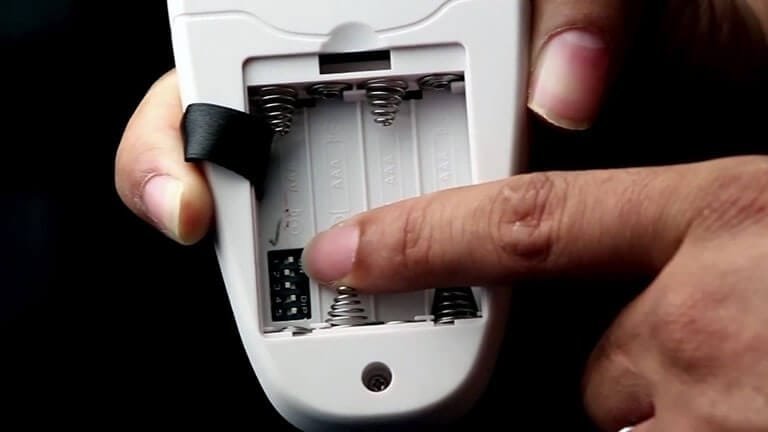Have you ever found yourself frustrated with your Tr313A fan remote not responding? You’re not alone.
Many users encounter issues where the remote seems to lose its connection or simply stops working altogether. But don’t worry—there’s a simple solution that can get your fan back up and running in no time. By mastering the art of resetting your Tr313A fan remote, you can regain control and enjoy the comfort of a perfectly tailored breeze once again.
You’ll discover quick and easy steps to reset your remote, along with tips to ensure it operates smoothly. Get ready to eliminate the hassle and bring convenience back into your life. Your perfect fan experience is just a reset away!
Understanding Tr313a Fan Remote
The Tr313A Fan Remote is a handy tool for controlling your fan. It offers the convenience of adjusting fan settings from a distance. This remote enhances the user experience by providing efficient control.
It is designed to be user-friendly and straightforward. With its intuitive interface, anyone can easily navigate through its functions. The Tr313A Fan Remote aims to provide seamless interaction between the user and their fan.
Features And Specifications
The Tr313A Fan Remote boasts several features designed for ease of use. It has a sleek design that fits comfortably in your hand. The buttons are well-placed for easy access.
This remote operates on a simple battery mechanism. It ensures long-lasting performance without frequent battery changes. The signal range covers a wide area, allowing control from different parts of the room.
Common Issues And Solutions
Occasionally, the Tr313A Fan Remote may face connectivity problems. Ensure the battery is properly installed to avoid this issue. Sometimes, the remote might not respond, requiring a simple reset.
For stubborn issues, check for obstructions blocking the signal. Position the remote closer to the fan for better communication. Regularly inspect the remote for physical damage to maintain optimal performance.
Importance Of Remote Reset
When dealing with technology, sometimes things don’t work as expected. You might have experienced issues with your Tr313A fan remote, where buttons don’t respond or settings change on their own. This is where the importance of a remote reset comes into play. Resetting your remote can often solve these problems, restoring functionality and ensuring your device operates smoothly. But why is this process so crucial?
Benefits Of Resetting
Resetting your Tr313A fan remote can bring several benefits. Firstly, it can resolve unresponsive buttons, a common frustration for users. Imagine you’re trying to adjust the fan speed, but nothing happens. A quick reset can fix this, allowing you to control the fan effortlessly again.
Another advantage is improved connectivity between the remote and the fan. If the remote and fan lose sync, resetting can reestablish the connection. This ensures your commands are accurately transmitted, making your experience seamless.
Resetting can also clear any incorrect settings that might have been accidentally programmed. You can start fresh, with the default settings, and customize them to suit your needs. This is particularly useful if multiple users have been adjusting the fan without coordination.
When To Consider A Reset
You might wonder when it’s appropriate to reset your Tr313A fan remote. Consider a reset when the remote becomes unresponsive. If pressing buttons yields no results, it’s time for a reset.
Another scenario is when the fan settings change unexpectedly. If the fan speed or mode shifts without your input, a reset can help stabilize the settings. This ensures your fan operates according to your preferences.
Finally, if you’ve tried other troubleshooting methods without success, a reset might be your solution. It’s a simple process that can save you from frustration and potential replacement costs. Have you ever been in a situation where a reset solved your tech issues? It’s surprising how often this straightforward action can be the key to resolving problems.
Tr313A Fan Remote Reset [Here is the Step-by-step Reset Guide]

The Tr313A Fan Remote Reset is a simple yet essential task. Sometimes, resetting the remote can solve many issues. This guide will walk you through each step. Follow the instructions carefully for best results.
Preparing For The Reset
Before starting, gather all necessary items. You will need the fan remote and a small tool. A paperclip or pen will work well. Make sure the fan is turned off for safety. Find a comfortable spot with good lighting.
Check the remote for a reset button. It is usually small and recessed. You might need the tool to press it. Ensure the remote has fresh batteries. Weak batteries can cause issues during reset.
Executing The Reset Process
Press and hold the reset button with your tool. Hold it for about 10 seconds. Release the button after the time passes. Look for a light or sound indicating a reset. This confirms the process is successful.
Test the remote to ensure it works. Turn on the fan using the remote. Try different settings to see if they respond. If the fan operates as expected, the reset worked. If not, repeat the process once more.
Troubleshooting After Reset
Struggling with the Tr313A fan remote reset? Quick troubleshooting can help fix common issues. Ensure proper battery installation and reset sequence.
When you hit the reset button on your Tr313A fan remote, you hope for a smooth restart. But what if things don’t go as planned? Troubleshooting after a reset can be a daunting task, but with the right approach, you can resolve issues effectively. In this section, we’ll delve into identifying persistent problems and offering advanced troubleshooting tips.
Identifying Persistent Issues
After a reset, your fan might still not function as expected. Begin by checking the basics. Are the batteries in your remote working? A simple battery replacement can often resolve many issues. Next, ensure that the remote and the fan are paired correctly. Sometimes, the reset can disrupt the connection. Double-check the pairing instructions in your user manual. Look for any physical obstructions. Is anything blocking the signal between the remote and the fan? Even furniture or decorative items can interfere with the remote’s signal.
Advanced Troubleshooting Tips
If basic checks don’t solve the problem, it’s time for advanced troubleshooting. Start by testing the remote’s frequency. Use a smartphone camera to see if the remote emits infrared signals when a button is pressed. If not, the remote might be faulty. Inspect the fan itself. Ensure the fan’s receiver is operational. Dust and debris can sometimes cause malfunctions. A gentle cleaning might restore proper functionality. Consider the fan’s settings. Are they correct for your desired operation? Settings may revert to default after a reset, and you may need to reconfigure them to your preference. If you’re still facing issues, it might be time to consult the manufacturer’s support. They can offer detailed guidance specific to your model. Have you encountered a tricky issue that required more than the usual fixes? Share your experience in the comments to help others navigating similar challenges.
Preventing Future Problems
Dealing with remote control issues can be a real nuisance, especially when you rely on devices like the Tr313A fan remote to maintain comfort in your home. To keep your remote running smoothly, it’s essential to focus on preventive measures. By taking simple steps now, you can avoid future headaches and ensure your device works when you need it most.
Regular Maintenance Tips
Regular maintenance can save you from unexpected remote failures. Start by checking the batteries. Weak or dead batteries can cause your remote to malfunction, so replace them every few months or whenever you notice a lag in response.
Keep the remote clean. Dust and grime can build up, interfering with the buttons’ function. Wipe it gently with a soft, dry cloth. If you have kids, teaching them to handle the remote with care can prevent accidental drops or spills.
Optimizing Remote Performance
Positioning matters. Ensure that the remote has a clear line of sight to the fan’s receiver. Obstructions can lead to signal issues, resulting in poor performance.
Consider resetting the remote periodically. A simple reset can clear any glitches and recalibrate its settings. Following the manufacturer’s instructions for resetting can make a huge difference in performance.
Have you ever thought about how environmental factors affect your remote? Extreme temperatures and humidity can impact its performance. Keeping it in a moderate environment prolongs its lifespan.
Do you have any tips or personal experiences with maintaining your Tr313A fan remote? Sharing your insights can help others avoid common pitfalls and enjoy a seamless experience. By taking these preventive measures, you’re setting yourself up for success and peace of mind.
Frequently Asked Questions
How Do I Reset My Tr313a Fan Remote?
Resetting is simple. Remove batteries. Wait 10 seconds. Reinsert batteries. Press the power button.
Why Is My Tr313a Remote Not Working?
Check the batteries first. Replace if needed. Ensure no interference from other devices. Reset if necessary.
Can A Power Outage Affect My Tr313a Remote?
Yes, it can. A power outage may require resetting the remote. Follow the reset steps provided.
How To Sync Tr313a Remote With Fan?
Turn off the fan. Hold the remote’s power button. Turn the fan back on. This resyncs them.
What If My Tr313a Remote Still Doesn’t Work?
Try new batteries. Ensure no obstructions. Reset once more. Contact support if problems continue.
Conclusion
Resetting your Tr313A fan remote is simple and effective. Follow the steps carefully. Enjoy a smooth and responsive fan experience. Regular resets can solve minor issues. A well-functioning remote enhances comfort and convenience. No need for complex solutions. Just a few easy steps.
Keep your fan remote in top condition. Proper maintenance ensures longevity. Troubleshooting becomes a breeze. Stay cool and relaxed with a reliable fan remote. Your comfort is just a reset away.
